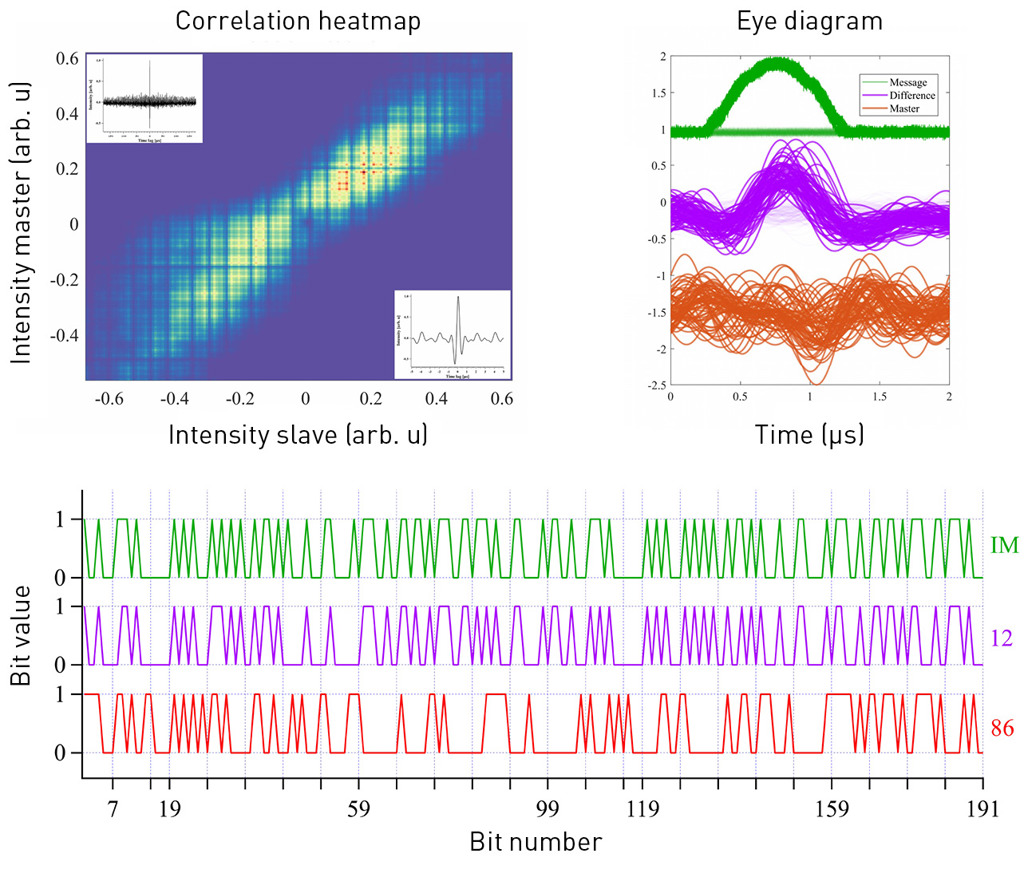 Top left: Evaluation of the chaos synchronization quality between the master and slave units. Bottom: Binary code for initial private message (green) with its binary translation for a legitimate receiver (purple) and an illegitimate receiver (red), with the number of errors for each case. Top right: Eye diagrams for the three aforementioned conditions.
Top left: Evaluation of the chaos synchronization quality between the master and slave units. Bottom: Binary code for initial private message (green) with its binary translation for a legitimate receiver (purple) and an illegitimate receiver (red), with the number of errors for each case. Top right: Eye diagrams for the three aforementioned conditions.
With the advent of the Internet of Things era, high-speed alternatives to fiber networks will become crucial for increasing data transfer capabilities. One current focus involves free-space schemes beyond those already used for radio transmission. Mid-infrared wavelengths, which are less affected by atmospheric conditions than conventional near-infrared wavelengths, could have advantages in this realm.1 The beam directivity and the stealth conferred by the background emission make communication systems based on long-wave infrared quantum cascade lasers (QCLs) even more desirable.
Some applications, however, require a further level of privacy—and when privacy is at stake, quantum key distribution (QKD) seems to check all the boxes, because it relies on the properties of quantum physics. Yet QKD is not yet available at mid-infrared wavelengths, and for other wavelengths implementation remains complex.2
There is another approach to protecting communications links against eavesdroppers: chaos-based enciphering. This has been experimentally investigated in optics since the end of 1990s, and has since been extended to several near-infrared laser configurations.3 Using this concept, we recently demonstrated a free-space cryptosystem using mid-infrared QCLs.4
Our successful message enciphering took advantage of the complex nonlinear dynamics that QCLs exhibit when subjected to external optical feedback.5 In our experiment, a chaotic master QCL is used to conceal the private message, while the deciphering is achieved with a second, identical (to the extent possible) remote QCL, referred to here as the slave.
The deciphering process relies on chaos anti-synchronization, whereby the slave reproduces only the reversed chaotic pattern of the master, thus allowing the recovery of the private message by adding the slave signal and the master signal. We assessed the privacy of our system and showed that an illegitimate receiver would end with a detrimental error rate during translation, even in the unlikely case in which the eavesdropper knew the coding format of the private message.
We believe our private communication system brings a cost-effective, reliable and versatile alternative for free-space data links, especially in harsh environments where mid-infrared lasers strongly outperform their near-infrared counterparts. Features such as room-temperature operation and high-speed transmission can further ease large-scale deployment. We thus anticipate that this finding can have a significant impact on the development of novel applications based on QCLs.
Researchers
Olivier Spitz, Télécom Paris, Institut Polytechnique de Paris, Palaiseau, France
Frédéric Grillot, Télécom Paris, Institut Polytechnique de Paris, Palaiseau, France, and University of New Mexico, Albuquerque, NM, USA
References
1. X. Pang et al. Phys. Status Solidi A 218, 2000407 (2021).
2. E. Diamanti et al. npj Quantum Inf. 2, 16025 (2016).
3. A. Argyris et al. Nature 438, 343 (2005).
4. O. Spitz et al. Nat. Commun. 12, 3327 (2021).
5. L. Jumpertz et al. Light Sci. Appl. 5, e16088 (2016).

